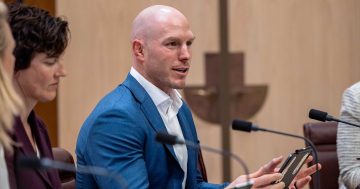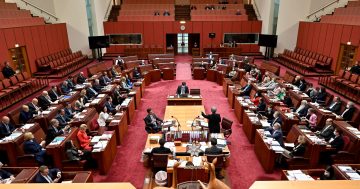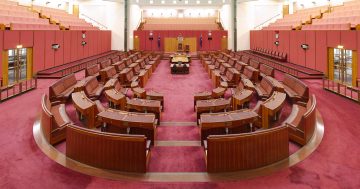
ACT independent Senator David Pocock wants the recommendation around Territory representation to go even further. Photo: Michelle Kroll.
The ACT could have double the number of senators come the next election if the Albanese Government agrees to the recommendation from a new report.
A Commonwealth joint standing committee into electoral matters has made 21 recommendations, including increasing the number of Territory senators from two to four for a three-year term.
During hearings, ACT independent Senator David Pocock had argued the extent to which senators represented the interests of their state had “diminished considerably” over time, as senators from major political parties “prioritise party discipline rather than state representation”.
“The principle of one vote, one value could be applied to the Senate by using Australia as a single electorate with senators elected by proportional representation,” he argued.
“This mechanism would align proportional representation as a method of electing Senators with the goal of one vote, one value, resulting in a more representative system.”
It was pointed out during hearings that the population of the ACT is roughly 81.5 per cent of the population of Tasmania, yet that state elects six times as many senators as the ACT.
But Mr Pocock wanted the committee’s recommendation to go even further.
“Rather than simply stipulating a new number (four), the base level of representation should be legislated as needing to be more than one-third, but less than two-thirds of the States’ Senate allocation,” he wrote in his additional comments to the report.
“While four senators fit within this, adding such guidelines would ensure that Territory representation would grow proportionally with the electorate as it will for the States, thus providing a permanent structural solution aligned with the values of representative democracy.
“This provides a durable solution that can be used into the future should the level of representation from the States change. Territories should not have to continually fight to ensure that they are fairly represented in the Federal Parliament.”
This suggestion would result in the ACT and the NT having six senators each.
In line with other jurisdictions, Mr Pocock also suggested increasing terms from three to six years, commencing on 1 July following the election.
“This would mean three senators up for election every three years,” he said.
The Coalition senators on the panel issued a dissenting report, stating increasing the number of Territory senators “in isolation” would, in fact, “worsen malapportionment” (ie, an inequitable or unsuitable appointment of representatives to a legislative body).
They pointed out in the last election that 16,753,557 voters elected 36 senators across Australia’s six states, on average representing 465,377 votes per senator. However, the ACT had 314,025 votes, and the NT 145,851 votes, to elect two senators each.
“As such, a senator representing a State required four times as many votes as a senator representing a Territory,” their dissenting statement noted.
“If [this recommendation] is adopted, then a senator from New South Wales would require 25 times more votes than a senator from the Northern Territory to be elected. The Coalition members of the committee oppose increasing the number of Territory senators on the grounds that it would be the greatest level of malapportionment since Federation.”
Ultimately, the committee’s stance was that it wasn’t appropriate to base territory representation in the Senate on population statistics.
“State representation in the Senate is not based on population, and it is unconvincing to argue that territory representation in the Senate should be,” it stated.
“The Committee considers that territory representation should reflect the intent of the Constitution such that territory representation should be considered on a similar basis to the representation of the smaller states in the Senate.
“The Federal Parliament’s ability to over-rule territory legislation further highlights the need for the two territories to be appropriately represented in the Parliament.”
It’s a move that the government’s already been urged to adopt, with the Australia Institute noting the country’s population had increased by 10 million since the number of parliamentarians last increased in the 1980s.
“[This is] leaving MPs and senators stretched too thinly. More politicians means more accessible local members and more attention on community issues,” Democracy and Accountability Program director Bill Browne said.
“An increase in the number of senators for the ACT and Northern Territory would be very welcome, bringing their representation closer to what other smaller jurisdictions enjoy and ensuring each territory would have a representative in both opposition and government party rooms.”
A separate recommendation called on a possible inquiry into increasing the size of the House of Representatives to reduce malapportionment and improve the ratio of electors to MPs.
Several other recommendations focused on transparency and accountability in government, including ending the ‘media blackout’ on political advertising during election periods, ensuring postal votes are returned directly to the Australian Electoral Commission instead of being collected by political parties first, and exempting registered charities from donation caps (should donation caps be implemented).
The government has no deadline to respond to the recommendations. However, it has been urged to do so quickly so that any electoral reforms can be implemented and understood well before the next federal election.





















